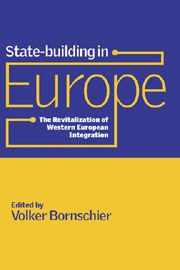Book contents
- Frontmatter
- Contents
- List of figures and tables
- List of contributors
- Preface
- Acknowledgements
- Part I State-building and Political Entrepreneurship
- 1 Western Europe's move toward political union
- 2 Tying up the Luxembourg package of 1985
- Part II The Core Elements in Recasting the European Bargain
- Part III Conclusions beyond the Single European Act of 1986
- Appendix List of interview partners
- Bibliography
- Index
1 - Western Europe's move toward political union
Published online by Cambridge University Press: 10 October 2009
- Frontmatter
- Contents
- List of figures and tables
- List of contributors
- Preface
- Acknowledgements
- Part I State-building and Political Entrepreneurship
- 1 Western Europe's move toward political union
- 2 Tying up the Luxembourg package of 1985
- Part II The Core Elements in Recasting the European Bargain
- Part III Conclusions beyond the Single European Act of 1986
- Appendix List of interview partners
- Bibliography
- Index
Summary
The revitalization of Western Europe
The 1980s witnessed dramatic changes in world society. Political orders that seemed to be rigidly fixed changed within only a few years. The sudden acceleration of West European integration is a case in point and the topic of this volume. To be sure, another historic event needs mentioning. In the short time between November 1989 – the fall of the Berlin Wall – and the end of 1991 – the official dissolution of the Soviet Union – the East–West conflict, which had marked the postwar era, became history.
In a booklet distributed at Seville's 1992 Universal Exposition, the European Community (EC) presents itself to the world as follows:
Now an economic giant, the Community is striving to consolidate the Single Market into an economic and monetary union and to put in place political structures that will give it a prime role in helping define the post-Cold War world order. (CEC 1992: 2)
Since the post-Cold War world order is mentioned in the above quote, the coincidence in time of the Treaty on European Union – agreed by the heads of state and government of the European Community at their summit in Maastricht in December 1991 – along with the dissolution of the Soviet Union and German reunification could suggest that state-building in Europe and the end of the East–West divide are related. However, this is a mistaken perspective. Western Europe embarked on its path to a new and additional form of statehood as early as the first half of the 1980s, as manifested in the Single European Act signed in February 1986 by the then twelve member states.
- Type
- Chapter
- Information
- State-building in EuropeThe Revitalization of Western European Integration, pp. 3 - 37Publisher: Cambridge University PressPrint publication year: 2000
- 7
- Cited by



